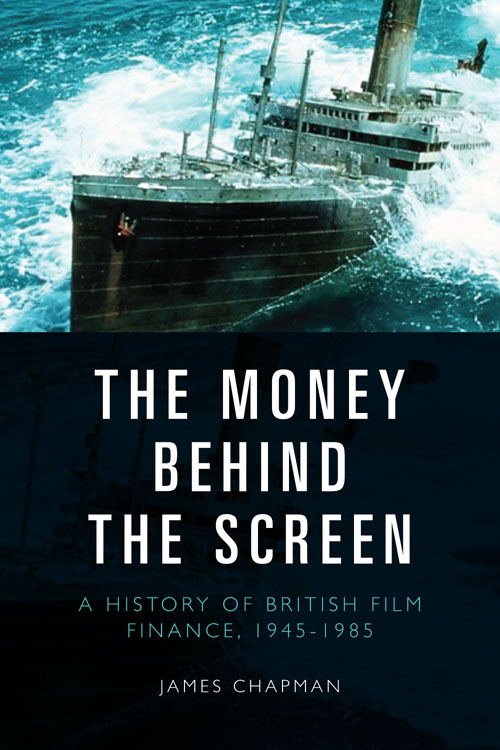
by James Chapman

Big research projects take a while to bear fruit. In the case of The Money Behind the Screen, it was the best part of nine years. The book’s origins extend back to the summer of 2013, when I first undertook research in the archive of completion guarantor Film Finances.
Film Finances – established in London in 1950 and now a truly global company with offices in Los Angeles, Germany, Sweden, South Africa, Australia and China – had opened its archive of British films to researchers. Along with several fellow British film historians – including Charles Drazin, Sarah Street, Sue Harper, Justin Smith and Sheldon Hall – I had the opportunity to mine the archive which included boxes on around 800 films for which Film Finances had provided its guarantee of completion between 1950 and 1980. These materials include budgets, scripts, financing and distribution contracts, production schedules, progress and cost reports, and miscellaneous production correspondence. It is the most detailed and comprehensive archival source for the post-war British film production industry.
We all came to the Film Finances Archive ‘blind’ as it were: not knowing what we might find let alone what the outcomes might be. How do you go about researching in an archive when you don’t even know what you expect to find?
My gut instinct was to look first at the ‘big’ films: therefore I went through the boxes on the major films guaranteed by Film Finances including The African Queen (1951), Dr No (1962), Tom Jones (1963) and Zulu (1964). The Archive offers an abundance of primary source material for researching and writing production case studies. Some of the fruits of this research can be found in a special issue of the Historical Journal of Film, Radio and Television in 2014.
Yet the more archive boxes I looked at – extending beyond just the best-known films and considering the full range of projects guaranteed by Film Finances – the more I got a sense that there was a ‘bigger picture’ waiting to emerge. The Archive offered much more than a series of production case studies: here was a history of the financing of British films – including the structure and patterns of film finance – that had yet to be written. And that was the origin of the bigger project that became The Money Behind the Screen.
The next step was to connect the Film Finances Archive to other sources. A file of correspondence between Film Finances’ managing-director Robert Garrett and successive directors of the National Film Finance Corporation pointed me to the records of the NFFC held by the National Archives. The NFFC was the government-sponsored ‘film bank’ set up in 1948 to provide loans to British producers at a time when the British film industry faced an acute financing crisis. It was meant as a temporary expedient for five years: it became a semi-permanent feature of the landscape of film finance until it was finally wound up in 1985. The National Archives provided me with the broad policy context for my research to complement the single-picture case studies forthcoming from Film Finances.
Other archives then helped to fill in the gaps. The Bank of England Archive holds materials relating to the initiative to set up a ‘film bank’ in the late 1930s as well as on the negotiations between the Treasury and the US Motion Picture Export Association over ‘blocked sterling’ during and after the Second World War. This was revenues earned in Britain by American distributors that could not be remitted back to the United States. The American companies could invest their ‘frozen’ funds in British production: Walt Disney’s live-action Treasure Island (1950) was one of the first outcomes of this policy.
The British Film Institute’s Special Collections also yielded much valuable material. There are no equivalents in Britain of the US studio archives donated to research libraries in America, but the papers of individual film-makers including Michael Balcon, Gerald Thomas and Sandy Lieberson include details of budgets and costs. A particularly illuminating feature of this research is the distinction between creative and economic agency. Peter Rogers – producer of the long-running ‘Carry On’ series – emerges as one of the most economical producers in British cinema history. In contrast Hugh Hudson, the critically acclaimed director of Chariots of Fire (1981) who went astray with the disastrous box-office flop Revolution (1985), had no idea how to budget a film.
Nine years (and two unsuccessful grant applications) later, The Money Behind the Screen has finally made it to print. It might not quite have taken me as long as it did for Richard Attenborough to realise Gandhi (1982), but in its own way it has been as much a labour of love. I hope that the broad narrative of film finance that I have mapped in the book will prompt other researchers to consider the economic and fiscal contexts in which films get to be made.
Because as Sir John Davis – managing-director of the Rank Organisation for over 30 years – once remarked: ‘No film can be made without finance.’

About the Book
The Money Behind the Screen maps the changing landscape of film finance in Britain during a transformative period for the film industry. It is the first book to document the sources of finance for film-making, the relations between film producers and financiers, and the wider fiscal and economic landscape of the British film production industry.
About the Author
James Chapman is Professor of Film Studies at the University of Leicester and Editor of the Historical Journal of Film, Radio and Television. His previous books include: A New History of British Documentary (2015), Past and Present: National Identity and the British Historical Film (2005) and The British at War: Cinema, State and Propaganda, 1939-1945 (1998).
Sign up for our mailing list!
Interested in learning more about this book and other titles from Edinburgh University Press? You can sign up for our mailing list here!
You can also read more of our film studies blogs here.





